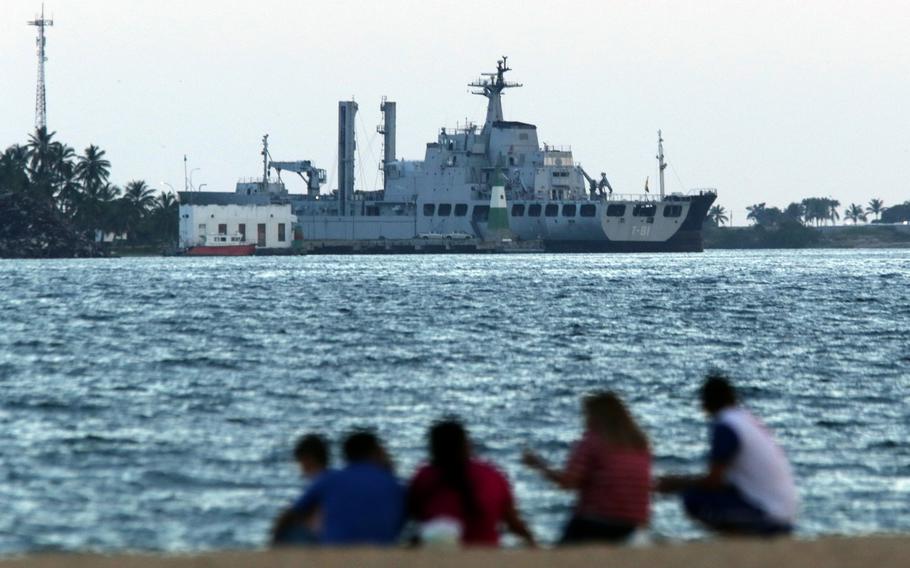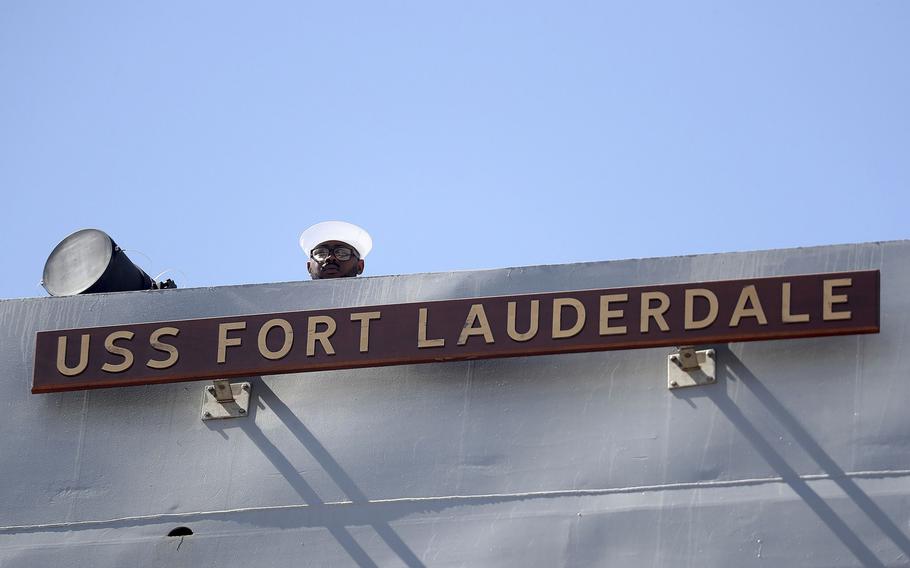
Venezuela keeps a warship on alert, following the announcement of the presence of U.S. Navy ships in the Caribbean Sea, in Puerto Cabello, Carabobo, Venezuela, on Aug. 16, 2025. (Juan Carlos Hernandez/ZUMA Press Wire via TNS)
(Tribune News Service) — The U.S. has added a powerful amphibious squadron to a previously revealed deployment of three Navy destroyers nearing Venezuela as part of a major counternarcotics operation.
Two officials familiar with the deployment, who spoke on condition of anonymity, told the Reuters news agency that three Navy warships — the USS San Antonio, USS Iwo Jima and USS Fort Lauderdale — could be stationed off the coast of Venezuela as early as Sunday. Together, the ships are carrying 4,500 service members, including a 2,200-strong Marine expeditionary unit.
The Pentagon has not publicly disclosed the mission, but sources told the news agency that the move aligns with a broader Trump administration ‘s aims at addressing threats to U.S. national security from specially designated “narco-terrorist organizations” in the region. Speaking about the possible use of U.S. military personnel in Venezuela, the White House said that the deployment underscores Trump’s pledge to use every instrument of American power — from sanctions to military force — to stop narcotics from reaching U.S. soil.
Cracking down on drug cartels is a pillar of Trump’s domestic and foreign policy. Earlier this year, the administration formally designated Mexico’s Sinaloa Cartel, Venezuela’s Tren de Aragua and several other groups as global terrorist organizations. The move gave U.S. agencies expanded authority to target cartel finances, logistics, and leadership.
Last month, the Trump administration designated the Cartel of the Suns — which U.S. prosecutors allege is run by Nicolás Maduro and other high-ranking members of his regime — as a “Specially Designated Global Terrorist” entity. The designation raises the possibility that the cartel could become a direct target of U.S. military action if chosen so by Trump.
The administration also raised the bounty for Maduro’s capture to an unprecedented $50 million.
Maduro and several of his top allies have been indicted by U.S. prosecutors for allegedly turning Venezuela into a narco-state through the so-called Cartel of the Suns. Maduro has dismissed the charges as a “rotting rerun” aimed at justifying foreign intervention.
In response to the U.S. military buildup in the Caribbean, Maduro announced Monday that his government will activate a special plan to mobilize more than 4.5 million militia members across Venezuela to “defend national sovereignty.”
“This week I’m launching a special plan to ensure coverage by more than 4.5 million prepared, activated, and armed militia members across the national territory,” Maduro declared during a televised event, flanked by senior commanders. He said the mobilization is needed to counter what he described as “extravagant, bizarre, and outlandish threats” from the United States.
Reacting to news from the United States, Maduro’s allies convened an extraordinary virtual summit of the countries that make up the Bolivarian Alliance for the Peoples of Our America, ALBA, where they condemned Washington’s “military deployment” in Caribbean waters.

A sailor stand at attention aboard the USS Fort Lauderdale, a San Antonio-class amphibious transport dock, during the commissioning of the ship on July 30, 2022, at Port Everglades in Fort Lauderdale, Florida. As an amphibious transport dock ship, USS Fort Lauderdale, with a motto of "Together We Fight," is designed as a warship to embark, transport and land elements of a landing force for a variety of expeditionary warfare missions. (Mike Stocker/South Florida Sun Sentinel via TNS)
In a statement issued after the meeting, Venezuela, Cuba, Bolivia, Nicaragua, Dominica, Antigua and Barbuda, Saint Vincent and the Grenadines, Saint Kitts and Nevis, Grenada and Saint Lucia warned that “the U.S. military deployment in Caribbean waters, disguised as counter-drug operations, represents a threat to the peace and stability of the region and constitutes a flagrant violation of international law.”
During the meeting, Cuban leader Miguel Díaz-Canel voiced support for Maduro, saying he is the target of Washington’s disinformation campaign launched with hostile intentions in mind.
“We also denounce, with equal firmness, the false accusations made by the United States government against President Nicolás Maduro, which seek to associate him — without foundation or evidence — with criminal organizations linked to illicit drug trafficking,” Diaz Canel said. “This is, once again, the type of maneuver imperialism resorts to when it harbors aggressive intentions against sovereign states, when it is unable to stifle the spirit of resistance of the people, and when it needs a fraudulent pretext to justify its actions.”
In Washington, meanwhile, officials are not ruling out the possibilty that the increased U.S. Navy presence in the Carabbean could eventually translate into a military intervention inside Venezuela.
“President Trump has been very clear and consistent: he’s prepared to use every element of American power to stop drugs from flooding into our country and to bring those responsible to justice,” said White House press secretary Karoline Leavitt after being asked by a McClatchy reporter on the chances of a boots-on-the-ground operation taking place inside the South American country. “The Maduro regime is not the legitimate government of Venezuela. It is a narco-terror cartel…. It is the view of this administration that Maduro is not a legitimate president. He is a fugitive head of this cartel who has been indicted in the United States for trafficking drugs into the country.”
The amphibious squadron will operate alongside three Arleigh Burke-class guided-missile destroyers — the USS Sampson, USS Jason Dunham, and USS Gravely — which are designed to counter threats from the air, land, sea and even undersea simultaneously.
The destroyers’ arsenal centers on a 96-cell vertical launch system that can be loaded with a mix of weapons, including Tomahawk cruise missiles for long-range land attacks, standard missiles for air and missile defense, and ASROC (Anti-Submarine Rocket) missiles for undersea warfare.
By adding amphibious vessels, the task force gains expanded land capabilities, particularly the ability to quickly deploy Marines into coastal zones.
Here’s a closer look at the ships:
USS San Antonio: Commissioned in 2006, the San Antonio is the lead ship of its class of amphibious transport docks and the first Navy vessel to integrate advanced stealth features. Designers minimized its radar cross-section by enclosing antennas inside masts, recessing equipment, and reshaping the anchor pocket. The ship’s primary mission is to embark, transport and land Marines with their equipment and supplies. Its ability to deploy forces rapidly makes it a key asset in operations near hostile shores.
USS Iwo Jima: A Wasp-class amphibious assault ship commissioned in 2001, the Iwo Jima carries both symbolic and operational weight. Named after the iconic World War II battle, its keel holds the Medal of Honor citation of Captain Jacklyn H. Lucas, one of the youngest recipients of the award. With a full-length flight deck capable of supporting helicopters and tilt-rotor aircraft, the ship functions much like a small aircraft carrier. It can deploy Marines by air and sea, coordinate large-scale missions and sustain prolonged operations.
USS Fort Lauderdale: The newest of the three, the Fort Lauderdale is a transitional vessel that blends San Antonio-class features with innovations intended for the Navy’s next-generation amphibious warfare ships. Commissioned in 2022, it is the first Navy ship named after the South Florida city.
©2025 Miami Herald.
Visit miamiherald.com.
Distributed by Tribune Content Agency, LLC.